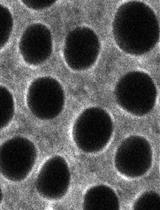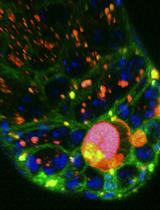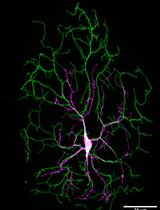- EN - English
- CN - 中文
Rapid IFM Dissection for Visualizing Fluorescently Tagged Sarcomeric Proteins
快速解剖间接飞行肌用于荧光标记肌节蛋白的观察
发布: 2017年11月20日第7卷第22期 DOI: 10.21769/BioProtoc.2606 浏览次数: 10975
评审: Jyotiska ChaudhuriAnonymous reviewer(s)
Abstract
Sarcomeres, the smallest contractile unit of muscles, are arguably the most impressive actomyosin structure. Yet a complete understanding of sarcomere formation and maintenance is missing. The Drosophila indirect flight muscle (IFM) has proven to be a very valuable model to study sarcomeres. Here, we present a protocol for the rapid dissection of IFM and analysis of sarcomeres using fluorescently tagged proteins.
Keywords: Dissection (解剖)Background
The cytoskeletal structures that enable contractility of striated muscle fibers are hundreds of cables called myofibrils. Myofibrils in turn are an array of serially arranged sarcomeres, all contracting simultaneously. The sarcomere is a perfectly symmetrical structure that contains all the elements required for contraction. At the center of the sarcomere lies the M-line, where myosin thick filaments are anchored. Flanking the sarcomere are the Z-discs, where actin thin filaments are anchored.
Muscular dystrophies are inherited disorders that cause progressive skeletal muscle weakness (Schröder and Schoser, 2009). There is no cure for muscular dystrophy, likely due to an incomplete understanding of the molecular mechanisms that underlie muscular dystrophies (Olive et al., 2013). Drosophila melanogaster is an effective genetic model organism to study muscle biology owing to its short life span, economical maintenance, and abundant available resources (Hales et al., 2015; Wangler et al., 2015).
Flight in Drosophila is powered by the synchronized action of the indirect flight muscles (IFM), the biggest muscles in flies, which are further subdivided into dorsal longitudinal muscles (DLM) and dorsal ventral muscles (DVM). The IFM share many fundamental similarities with human skeletal muscle: contraction mechanism, developmental steps, overall ultrastructure, and protein components (Vigoreaux, 2001). For example, the myopathy-related proteins ZASP and Filamin-C have fly homologs that when mutated develop muscle phenotypes (Liao et al., 2016; Gonzalez-Morales et al., 2017). Despite the advantages of using the IFM for muscle research, IFM dissection can be challenging and time-consuming. Here we present a protocol that combines fast and easy IFM dissection with high-quality imaging of the IFM using fluorescent proteins. We also provide a strategy for analyzing mutant phenotypes and quantifying sarcomeres by semi-automatic detection of sarcomere components.
Materials and Reagents
- Surgical blade (FEATHER Safety Razor, catalog number: No. 23 )
- 1.5 ml microcentrifuge tube
- Pipette tips
- Conventional needles PrecisionGlide 23 G 1 in. (Fisher Scientific, catalog number: 14-826-6B)
Manufacturer: BD, catalog number: 305193 . - BD disposable syringes (BD, catalog number: 309628 )
- Cover Glass No. 1 ½ 22 x 30 mm (e.g., Corning, catalog number: 2850-22 )
- Microscope slides (e.g., Fisher Scientific, catalog number: 12-552-3 )
- Flies expressing sarcomere fluorescent markers (e.g., Zasp52-GFP, Table 1)
- Custom-made 3.5% agar-filled 60 x 15 mm Petri dish plate (BioShop, catalog number: AGR003 )
- Phalloidin-Tetramethylrhodamine B isothiocyanate (TRITC) (Sigma-Aldrich, catalog number: P1951 )
- Phalloidin-Fluorescein Isothiocyanate (FITC) (Sigma-Aldrich, catalog number: P5282 )
- Mounting media ProLong Gold Antifade Mountant (Thermo Fisher Scientific, InvitrogenTM, catalog number: P36934 )
- Magnesium chloride (MgCl2)
- Ethylene glycol-bis-tetraacetic acid (EGTA) (Sigma-Aldrich, catalog number: E3889 )
- Adenosine triphosphate (ATP) (BioShop, catalog number: ATP007 )
- 1,4-Dithiothreitol (DTT) (BioShop, catalog number: DTT001 )
- cOmpleteTM, EDTA-free Protease Inhibitor Cocktail (Roche Diagnostics, catalog number: 11873580001 )
- Glycerol (BioShop, catalog number: GLY001 )
- Triton X-100 (BioShop, catalog number: TRX777 )
- 8% paraformaldehyde aqueous solution glass vial (Electron Microscopy Sciences, catalog number: 157-8 )
- Sodium chloride (NaCl)
- Potassium chloride (KCl)
- Sodium phosphate dibasic (Na2HPO4)
- Potassium phosphate dibasic (K2HPO4)
- Relaxing solution (see Recipes)
- Relaxing-Glycerol solution (see Recipes)
- 8% paraformaldehyde (see Recipes)
- 10x phosphate buffered saline (PBS) (see Recipes)
- 1x PBS, 0.1% Triton X-100 (PBST) (see Recipes)
Equipment
- CO2 Flypad, standard size (8.1 x 11.6 cm) (Genesee Scientific, Flystuff, catalog number: 59-114 )
- Blade handle for surgical blade (FEATHER Safety Razor, catalog number: No. 4 )
- Glass Petri dish; 60 x 15 mm (VWR, catalog number: 89000-770)
Manufacturer: DWK Life Sciences, KIMBLE®, catalog number: 2306-10010 . - Stereo microscope (Leica Microsystems, model: Leica MS5 )
- Dumont #5 forceps (Fine Science Tools, catalog number: 11251-30 )
- Incubator set to 25 °C
- P2, P20, P100, and P1000 Micro Pipettes (e.g., Gilson, catalog numbers: F144801 , F123600 , F123615 and F123602 )
- Platform mixers (e.g., Speci-Mix Test Tube Rocker) (Thermo Fisher Scientific, Thermo ScientificTM, catalog number: M71015Q )
- Medium-sized pointed brush
- Standard fly husbandry equipment
Software
- Fiji (https://fiji.sc/)
- R Statistics package (https://www.r-project.org/)
Procedure
文章信息
版权信息
© 2017 The Authors; exclusive licensee Bio-protocol LLC.
如何引用
Xiao, Y. S., Schöck, F. and González-Morales, N. (2017). Rapid IFM Dissection for Visualizing Fluorescently Tagged Sarcomeric Proteins. Bio-protocol 7(22): e2606. DOI: 10.21769/BioProtoc.2606.
分类
发育生物学 > 形态建成 > 细胞结构
细胞生物学 > 组织分析 > 组织成像
您对这篇实验方法有问题吗?
在此处发布您的问题,我们将邀请本文作者来回答。同时,我们会将您的问题发布到Bio-protocol Exchange,以便寻求社区成员的帮助。
提问指南
+ 问题描述
写下详细的问题描述,包括所有有助于他人回答您问题的信息(例如实验过程、条件和相关图像等)。
Share
Bluesky
X
Copy link












